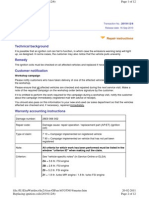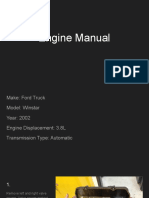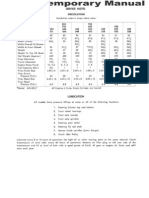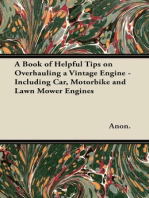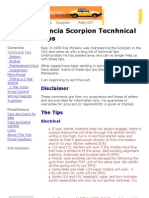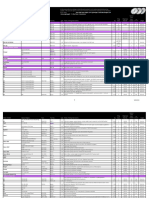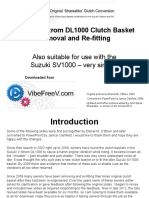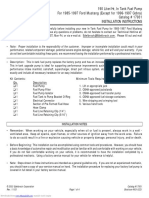Weber 3236 Adjust
Weber 3236 Adjust
Uploaded by
Narendra WijayasuriyaCopyright:
Available Formats
Weber 3236 Adjust
Weber 3236 Adjust
Uploaded by
Narendra WijayasuriyaOriginal Description:
Copyright
Available Formats
Share this document
Did you find this document useful?
Is this content inappropriate?
Copyright:
Available Formats
Weber 3236 Adjust
Weber 3236 Adjust
Uploaded by
Narendra WijayasuriyaCopyright:
Available Formats
Electric Choke
(Loosen ring to adjust)
Weber 32/36 Carburetor Adjustment
Weber Carburetor Adjustment Procedure.
(3a) Idle Jet
& Screw Mount
(1) First, perform the various engine tests & adjustments;
Compression, Points, Timing, Vacuum, etc.
(2) Clean Carburetor with carburetor-cleaner, spraying down
the main throats of the carburetor (with running engine at
a fast idle, to prevent stalling).
(3) Carefully remove the Idle Jet (3a) and the Mixture Screw
(3b). Clean the jet and screw using the carburetor cleaner
as well as the carburetor passages. Reinstall the Idle Jet, &
fully screw in the Idle Mixture Screw, lightly bottoming
out the screw and back it off 2 full 360 degree turns.
Passenger Side Linkage
(4c) Throttle
Grommet at
firewall
Return
Spring
(4b) Spring
clip, attaches
rod end to
carb linkage
Attaches to Carburetor
Idle Speed Screw
(3b) Idle Mixture
Screw
Linkage Adaptor
Bracket & Ball Stud Nut
(4) Next check the adjustment and full operation of
the carburetor acceleration linkage.
(4a) Check the 3 gas pedal to firewall mounting
screws are tight,
(4b) Ensure the ball and socket fittings on the linkage are cleaned and lubricated. (check for missing
spring clip retainers)
(4c) Check that the two throttle grommets on the
firewall are present, clean and greased.
(4d) Adjust Throttle Control Rod, so that carburetor
linkage is fully opened when the gas pedal is floored
NOTE: If equipped with an automatic transmission,
also adjust the Kickdown detent cable. (See Opel
factory service manual for instructions).
Hose Port for
Vacuum Advance
Drivers Side Linkage
14mm Fuel
Inlet fitting
(reversible
on newer
models)
(Linkage toward
Carburetor)
(Drawings are Not to Scale)
(4d) Adjust
Throttle
Control Rod here
(4c) Clean
Automatic
Transmission
Detent Cable
Mount Hole
(if equipped)
(4a)
Gas
Pedal
Screws
and lube rod
end, and
insert throttle
grommet
(in the firewall
area hole
closest to the
fender).
Weber Carb Lean Idle Adjustment Method: (at home)
Run the engine until it is warmed up and the choke is fully opened and disengaged.
Rotate the Idle Speed screw counter-clockwise, until tachometer reads about 600-700
rpms (as low as it can idle, with the engine still running). Next rotate the
Idle Mixture crew (3b), also known as the fuel mixture adjustment screw) clockwise,
until the engine runs rough.
Next turn the Idle Mixture screw (counter-clockwise) 1/2 to 3/4 of a full turn, so that
the engine again runs smoother. Next increase the idle speed by rotating the Idle
Speed screw clockwise. Most Opels Factory idle speed setting is 850RPM, but most
owners adjust their idle between 1000-1100 RPM
Note: Too High of an idle speed will engage the distributors mechanical advance
affecting ignition timing.
a.k.a. Idle Mixture Screw (3b)
Usually this is a 8mm screw.
View is from the windshield
area, where carb linkage is.
Note: Above procedure is for home. Exact Fuel Mixture adjustment is performed at a shop.
Additional Weber Carb Notes:
Idle Mixture Screw Circuit Function
Setting Choke: The choke is adjusted, by loosening the three screws on its ring, then
rotating the choke clockwise for less choke, and counter-clockwise for more choke.
Note: The Fast Idle Speed screw is located behind the choke itself, and can be adjusted
to increase or decrease the fast idle rpm. A good fast idle speed (when the choke is
Too far in
Just Right
closed) is about 1700 RPM
Water Choke: The hoses attach to 2 T fittings coming from the heater hoses.
Electric Chokes: Wire to the #2 fuse (same switched circuit as the radio) on the Opel GT fuse box.
Avoiding Vapor Lock: This is a particular problem with all Opels in Summer time. Route fuel hose away from all hot engine surfaces.
Only install fuel filters after the fuel pump near the carburetor, staying clear of the thermostat housing. Installing a clear plastic fuel filter
near the carb, will let you see when fuel is vaporizing. Carrying and using starter spray is a quick-fix. A Carburetor heat shield also helps.
Weber Fuel Inlet Fitting: Newer Weber carbs have a reversible 14mm brass fuel inlet fitting, so you can relocate the fuel hose away
from the engine.
Fuel Regulator: A good prevention move, is installing a fuel pressure regulator on the hose leading to the carb, set at 3.5psi. Some
new mechanical fuel pumps, and some aftermarket electric fuel pumps can develop excessive pressure (which can flood some Webers).
Additional Information: Weber technical guides discuss operational circuit function and provide float adjustment specifications.
Weber carburetors are also highly tunable. If you upgrade cams, exhaust, ignition, the Weber is easily tuned for
more performance by changing the main fuel and idle fuel jets. Replacement parts are also readily available.
www.opelclub.com (6/2006)
You might also like
- Block Casting NumbersDocument29 pagesBlock Casting NumberspapipapiiNo ratings yet
- Tour MaxDocument250 pagesTour MaxRomaric SueurNo ratings yet
- Auto-Lite: Vendor Number Cross Reference ListDocument24 pagesAuto-Lite: Vendor Number Cross Reference ListArmoured CompNo ratings yet
- PRD Fireball ManualDocument53 pagesPRD Fireball ManualcgilbertNo ratings yet
- 28E9Document12 pages28E9cd_costa44570% (1)
- GXV160H213Z1V402VerV PDFDocument92 pagesGXV160H213Z1V402VerV PDFLupin GonzalezNo ratings yet
- Engine Removal PDFDocument8 pagesEngine Removal PDFsun kistNo ratings yet
- Engine ManualDocument22 pagesEngine Manualapi-467580822No ratings yet
- WheelHorse 1054 and 953 Temporary Manual and Service BulletinsDocument17 pagesWheelHorse 1054 and 953 Temporary Manual and Service BulletinsKevins Small Engine and Tractor Service100% (2)
- A Book of Helpful Tips on Overhauling a Vintage Engine - Including Car, Motorbike and Lawn Mower EnginesFrom EverandA Book of Helpful Tips on Overhauling a Vintage Engine - Including Car, Motorbike and Lawn Mower EnginesRating: 5 out of 5 stars5/5 (1)
- Weber 3236 DGV DrawingDocument1 pageWeber 3236 DGV DrawingFranco MaderaNo ratings yet
- Timing Chain SetsDocument12 pagesTiming Chain SetsJeff NiuNo ratings yet
- Cylinder Head InstallDocument2 pagesCylinder Head InstallMiguel Moreno FernándezNo ratings yet
- Onan Parts ManualDocument71 pagesOnan Parts ManualRon Schmitt100% (2)
- KwikWay Boring BarDocument48 pagesKwikWay Boring Barsales100% (1)
- 1957 CadillacDocument3 pages1957 CadillaclicenciadopedroNo ratings yet
- Fuel System Service Information - Honda 2004 CRF250X Service Manual (Page 99) ManualsLibDocument1 pageFuel System Service Information - Honda 2004 CRF250X Service Manual (Page 99) ManualsLibWedson GomesNo ratings yet
- CubCadet RZT S Series 2012 2014 Spec SheetDocument17 pagesCubCadet RZT S Series 2012 2014 Spec SheetRobby RenzNo ratings yet
- Kohler K Series Twin Cylinder Engine Torque Values and Sequences For Fasteners PDFDocument4 pagesKohler K Series Twin Cylinder Engine Torque Values and Sequences For Fasteners PDFBillW56No ratings yet
- Wheelhorse Tractor 1978-79 B, C & D-Series SM Section 1-4, Vol 1Document27 pagesWheelhorse Tractor 1978-79 B, C & D-Series SM Section 1-4, Vol 1torquevilleNo ratings yet
- 1997 Land CruiserDocument7 pages1997 Land CruiserDominic PaguioNo ratings yet
- Protex Drive ShaftsDocument64 pagesProtex Drive ShaftsoziautopartsNo ratings yet
- Dellorto X Series Needle Di..Document2 pagesDellorto X Series Needle Di..Carlos Bajo FNo ratings yet
- Two Cylinder ModelsDocument8 pagesTwo Cylinder ModelsPaul MartinNo ratings yet
- Carter Carburetor Identify Plunger Rod Assembly by Shaft NumberDocument3 pagesCarter Carburetor Identify Plunger Rod Assembly by Shaft Numberisland14No ratings yet
- Lancia Scorpion Tecnhnical TipsDocument11 pagesLancia Scorpion Tecnhnical Tipsphantom fiatNo ratings yet
- Manual de La Ambulancia Ford e 350 Año 2008Document285 pagesManual de La Ambulancia Ford e 350 Año 2008juan luis martinez rNo ratings yet
- Mountfield Westwood: Westwood Garden Tractors 1987 Parts CatalogueDocument13 pagesMountfield Westwood: Westwood Garden Tractors 1987 Parts CatalogueWinfried SibbertNo ratings yet
- NPC Performance Flywheel Catalogue 2023 Full List WEBSITEDocument9 pagesNPC Performance Flywheel Catalogue 2023 Full List WEBSITEskooba84No ratings yet
- MGB Ignition FeedbackDocument3 pagesMGB Ignition Feedbacktrouble monkeyNo ratings yet
- Westwood Gazelle SMDocument26 pagesWestwood Gazelle SMPeter TNo ratings yet
- Parts - 350 Exc-F 2016 ChassisDocument44 pagesParts - 350 Exc-F 2016 ChassisBenito Duarte de GodoiNo ratings yet
- Tractor Parts and Attachments - Front Wheel Bearing and Spindles PDFDocument4 pagesTractor Parts and Attachments - Front Wheel Bearing and Spindles PDFgovindkaniNo ratings yet
- Vortech SuperchargerDocument27 pagesVortech SuperchargerGreg MarankieNo ratings yet
- 2001 Chevy Astro HVAC SystemDocument205 pages2001 Chevy Astro HVAC SystemJuan BernalNo ratings yet
- Lifters - Flat FaceDocument2 pagesLifters - Flat Facecrower_scribdNo ratings yet
- Zenoah G230RC - G260RCDocument20 pagesZenoah G230RC - G260RCsousou0033No ratings yet
- Clutch Basket Replacement GBDocument70 pagesClutch Basket Replacement GBTomNo ratings yet
- Brigges and Straton Engine SpecificationDocument3 pagesBrigges and Straton Engine Specificationpvaibhav08No ratings yet
- Ford Mustang Mach 1Document4 pagesFord Mustang Mach 1Devraag C.MNo ratings yet
- 24L FourDocument28 pages24L FourIqbal NugrohoNo ratings yet
- Z-Force S-2010Document168 pagesZ-Force S-2010aa 267100% (1)
- Tomos Streetmate A55 - Information and Tuning ManualDocument29 pagesTomos Streetmate A55 - Information and Tuning ManualAdamLomazoff100% (1)
- Subaru EJ25 Engine Problems Reliability, Specs & ReviewsDocument1 pageSubaru EJ25 Engine Problems Reliability, Specs & Reviewszs2kk87g45No ratings yet
- Auxiliary Battery RelayDocument7 pagesAuxiliary Battery RelayRoland Dube0% (1)
- Volvo 244 Timing BeltDocument17 pagesVolvo 244 Timing BeltridyNo ratings yet
- Argo Atv Service Manual - Avenger - HDI - Section ES - Electrical (Rev. March 2017)Document36 pagesArgo Atv Service Manual - Avenger - HDI - Section ES - Electrical (Rev. March 2017)juanNo ratings yet
- 98687-200 Series Parts CatalogDocument222 pages98687-200 Series Parts Catalogboub1212No ratings yet
- 6-55 Hydraulic Equipment Pump & Adapting PartsDocument4 pages6-55 Hydraulic Equipment Pump & Adapting PartsPaull SalasNo ratings yet
- Rear Light Removal & Earthing FixDocument6 pagesRear Light Removal & Earthing FixKároly Dávid NyulasiNo ratings yet
- Holley Numerical Listings PDFDocument10 pagesHolley Numerical Listings PDFbatman2054No ratings yet
- Installing An ASD Differential in A Non ASD Car and Set Up For Fully Locking Manual OperationDocument9 pagesInstalling An ASD Differential in A Non ASD Car and Set Up For Fully Locking Manual Operationlucian scurtuNo ratings yet
- Mini and Metro Engine Numbers CCDocument11 pagesMini and Metro Engine Numbers CCFrancesco Matteoli0% (1)
- CHRYSLER - Spare CatalogueDocument8 pagesCHRYSLER - Spare CataloguetolgaNo ratings yet
- Intake Manifold/Upper Engine: 2009 Pontiac G8 G8 Service ManualDocument13 pagesIntake Manifold/Upper Engine: 2009 Pontiac G8 G8 Service ManualjaumegusNo ratings yet
- Weber - 32 - 36 - DGV-32 36 DGV-fil - F0oouDocument2 pagesWeber - 32 - 36 - DGV-32 36 DGV-fil - F0oouelbarto0100% (1)
- Genesis 3.8L Section 5Document86 pagesGenesis 3.8L Section 5Nacho MowjiNo ratings yet




